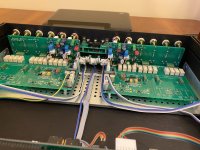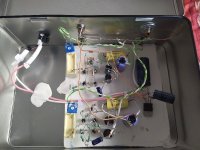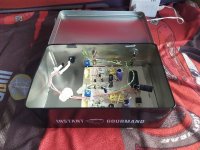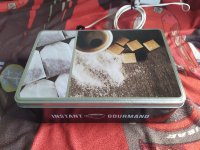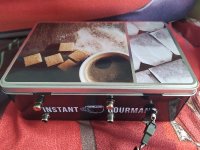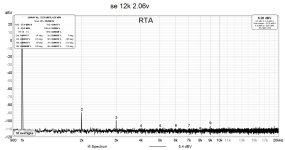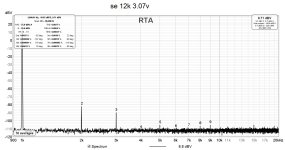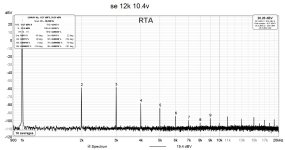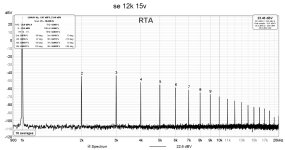In the post #1290 the THD, for the same output voltage, decreases as the output load increase. The simulation also shows the same decreases. REW and Spice also show in the a change in the phase of 2H. Can this affect the total THD?
Spice with supply +/- 23V prefers a lower load. 😡
Also in this case there is a change in the phase of 2H.
Spice with supply +/- 23V prefers a lower load. 😡
Also in this case there is a change in the phase of 2H.
Positive or negative doesn’t matter if the level(of h2) is the same you get same thd.
If you drive your amp with a preamp that has negative phase 2nd it doesn’t mean your amp will give you negative phase 2nd on the output.
Don’t loose your sleep with this.
Ltspice is good until a certain point from there on you need to build the gadget and test it in the real world.
If you drive your amp with a preamp that has negative phase 2nd it doesn’t mean your amp will give you negative phase 2nd on the output.
Don’t loose your sleep with this.
Ltspice is good until a certain point from there on you need to build the gadget and test it in the real world.
OTOH, if the H2 in the FE is out of phase with the H2 in the OS, some cancellation will occur. Which you may or may not want.
Hi,
I sort of completed this preamp with the parts that I had in hands. Some parts (pot and power connector) are still not there, but otherwise the preamp is fully functional.
For the reference, the amplifier is MoFo, the speakers are Alpair 10.3.
Previously I had used used a Jfet Boz Preamp with J310 jfet. To my ears, that preamp sounds wonderful on low to normal volumes. But, if you crank it up, is is not so nice.
Now, some sonic impressions of Frontend 2022 (as compared to Jfet Boz):
Sounds nice and clean. Nothing that irritates or "sounds wrong".
But, the soundstage is a bit narrower, the sound is more "dry" and there is less "air" between instruments.
At low volumes, Jfet boz sounds better (or more "musical" if you like).
At high volumes (with ZZ Top for example) Frontend 2022 sounds better.
I think that in the end it boils down to the amount of second harmonic (negative phase) that I like.
So, the quest continues...
I sort of completed this preamp with the parts that I had in hands. Some parts (pot and power connector) are still not there, but otherwise the preamp is fully functional.
For the reference, the amplifier is MoFo, the speakers are Alpair 10.3.
Previously I had used used a Jfet Boz Preamp with J310 jfet. To my ears, that preamp sounds wonderful on low to normal volumes. But, if you crank it up, is is not so nice.
Now, some sonic impressions of Frontend 2022 (as compared to Jfet Boz):
Sounds nice and clean. Nothing that irritates or "sounds wrong".
But, the soundstage is a bit narrower, the sound is more "dry" and there is less "air" between instruments.
At low volumes, Jfet boz sounds better (or more "musical" if you like).
At high volumes (with ZZ Top for example) Frontend 2022 sounds better.
I think that in the end it boils down to the amount of second harmonic (negative phase) that I like.
So, the quest continues...
Attachments
everything is better when you have good speakers
often repeated catch 22 is expecting of electronics to cover deficiency of most important link in chain
often repeated catch 22 is expecting of electronics to cover deficiency of most important link in chain
Goooooood job, nice!Hi,
I sort of completed this preamp with the parts that I had in hands. Some parts (pot and power connector) are still not there, but otherwise the preamp is fully functional.
For the reference, the amplifier is MoFo, the speakers are Alpair 10.3.
Previously I had used used a Jfet Boz Preamp with J310 jfet. To my ears, that preamp sounds wonderful on low to normal volumes. But, if you crank it up, is is not so nice.
Now, some sonic impressions of Frontend 2022 (as compared to Jfet Boz):
Sounds nice and clean. Nothing that irritates or "sounds wrong".
But, the soundstage is a bit narrower, the sound is more "dry" and there is less "air" between instruments.
At low volumes, Jfet boz sounds better (or more "musical" if you like).
At high volumes (with ZZ Top for example) Frontend 2022 sounds better.
I think that in the end it boils down to the amount of second harmonic (negative phase) that I like.
So, the quest continues...
Replacing the J113s in the input at Q1 and Q2 with single (or dual) 2SK170s, does one keep R7 to the stock 332 ohm value?
Or is there a more optimal value for a sweet spot other than 3mA CSS in the LTP when running the Toshibas?
Or is there a more optimal value for a sweet spot other than 3mA CSS in the LTP when running the Toshibas?
Yes, we still want to bias them at the same value, and the J113 as CCS is perfectly fine.
🙂
🙂
I want to implement a set of these FE’s to turn my F5 Turbo into an amp with balanced input. The amp has +/- 31 Volt rails. Will this still be OK? The J113 holds up to 70 V, but getting close here. Alternative is to insert a pair 7824/7924 stabilizers to bring down the voltage.
But as I read it Gerrit doesn't want to use a Ballenced -SE converter
he wants to convert the F5 to be an amp with ballenced inputs and as
the f5 doesn't have a diferential input stage I can see that might be
a problem.
he wants to convert the F5 to be an amp with ballenced inputs and as
the f5 doesn't have a diferential input stage I can see that might be
a problem.
The F5T has a single-ended input stage: no differential pair in the front end. My plan is to place the NP FE in the cabinet of the F5 T, feed it from the +/- 31 v of the F5T CRC PSU, and connect the output of the FE straigth to the input of the F5T. I will then insert XLR sockets in the rear panel, and a switch with which one can choose between XLR (balanced) or RCA (unbalanced) input. Of course, I will then use 0 dB gain in the FE, since the 20 dB gain of the F5T is enough for me.
your build looks great, Ben Mah! Thanks for the info about the 62 V.
your build looks great, Ben Mah! Thanks for the info about the 62 V.
I got the FE working on 48 V unipolar PSU, using the modified virtual ground approach of post #401. The Meanwell SMPS gave me -90 dB of hum/buzz. With the modified Virtual Ground definition, and Nelson's modification with the 10 Ohm degeration resistor, the noise level, including the 50 Hz and its harmonics, is below -130 dB, the noise level. Therefore the FE will not add any coloration to the F5T sound. The performace is a lot better than LTSpice suggests, but that is probably due to the faulty LTSpice model of the J113, as EUVL made clear in the UDNESS thread. This FE 2022 is once again one of Nelson Pass' little juwels: simple and elegant design and superb performance.
Last observation: the THD goes down dramatically with PSU voltage. I tested it with laboratory power supplies, between 7 V and 50 V, the THD goes down from -60 dB to -130 dB.
Yes, it is also somewhat load dependent. I’m currently operating with +/- 23 V rails and a gain of 20 dB, with load of around 6.8kOhms. This produces a better distortion profile than a load of 25k. YMMV. Point is, load is another variable for tuning.
- Home
- Amplifiers
- Pass Labs
- DIY Front End 2022
